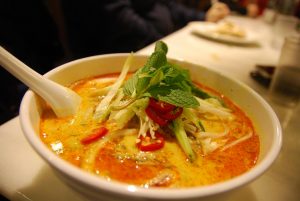Prawns are a delicious and tasty delicacy and ab easy crowd-pleaser, when it comes to entertaining. There are many different prawn species but King Prawns are some of the best known prawns. Because of their fairly neutral taste, prawns can be a wonderful base to a variety of recipes. Some prawn producers are sustainable, ethical, antibiotic-free and toxin-free so consumers do have the option to purchase prawns that are environmentally friendly! Buy from here http://aoseafood.co.uk/buy/king-prawns/
Benefits of King Prawns
Prawns are a wonderful asset to any healthy diet due to having zero carbohydrates, a low calorie count, high quality protein and many vitamins and minerals. The following numerous benefits can be gleaned from prawns:
- Zinc – promotes healthy immune system functioning
- iron – produces red-blood cells and oxygen-carrying proteins
- selenium – for immune system support
- magnesium – maintaining strong bones and regulating muscle and nerve function
- calcium – maintaining healthy bones
- phosphorous – aids in metabolic process and assists with bone building
- Vitamin A – healthy skin and an antioxidant
- Vitamin B-6 and B-12 – useful in producing energy, protects against heart disease and maintaining normal nerve functioning
- Vitamin E – improves fertility and is heart protective
- 6 grams of Omega-3 fatty acids per serving – which have been proven to support health by reducing the rick of atherosclerotic heart disease, improve skin hair and nails, metabolise fat and support brain function.
Control of water borne disease
Prawns are helpful in protection from Schistosomiasis, which is a disease that leads to chronically poor health. This is acquired when contact is made with fresh water containing the lava of parasitic blood flukes. The adult worms then live in the bloodstream. Prawns themselves due not support the parasite in their organs and so prevent the spread of the disease by eliminating the lava. Experts are looking into introducing prawns into water systems that are causing this disease.
What is the difference between prawns and shrimp?
The names prawn and shrimp are often used interchangeably but there is a difference between prawns and shrimp. Shrimp have smaller gill structure, legs and claws. Prawns usually have a longer, curled tail while shrimp have a shorter and straighter tail. However, in the UK, smaller prawns are referred to as shrimps and the larger ones as prawns whilst in the USA and Australisa, ‘shrimp’ is the preferred umbrella term. Check out this giant king prawn recently caught in the waters off Australia
Cooking
When buying prawns, choose ones that smell fresh and look wet. A fishy smell indicates that they are passing their use-by date. After cooking, also make sure that you eat them within twenty-four hours. King Prawns are usually sold raw and either with or without their heads. If the shell is on the prawn, you will need to peel them but prawns tastes better when peeling them post-cooking. Cooking prawns causes their shells to turn pink and retain a sweet flavour whilst the flesh turns white with a tinge of pink. When cooked too long, the prawn flesh may become tough. To peel the prawn after cooking, turn the prawn over and pull the shell open along its length. If you notice a black line along the prawn, this is the full intestinal tract and you can remove it easily with a knife for a better aesthetic appeal. Leaving it on is also acceptable since it is not harmful to eat these. Prawns may be cooked through poaching, steaming, pan sautéing or frying.
- Poaching
Poach prawns by cooking them in a low temperature liquid such as oil or coconut milk. The low temperature preserves the proteins of the prawns and prevents them from becoming tough too quickly. If you want to use the prawns in a salad or served immediately, dip them into iced water.
- Steaming
Steaming your prawns will also take longer and preserve the prawns by heating them gently. You may wrap the prawns in aluminium foil with parsley or coriander and onion, then cook in a moderate oven heat for ten minutes. You may also use a microwave steamer and cook until the prawns have turned pink.
- Pan Sautéing
Many recipes recommend this method of cooking since it brings out a delicious flavour in the prawns. Heat oil until it begins to smoke and then add the prawns. Use a good quality extra-virgin cold pressed olive oil, or coconut oil, which will provide you with additional nutrients. Drain and remove the excess oil on a paper towel.
- Frying
A batter used during frying can protect the vitamins and minerals in the prawn from the high heat used in frying. For example, cover them in a flour, salt, pepper and herb mixture before adding them to hot oil in the pan. Make sure to monitor the pan carefully, turning as needed.
Fun Recipes to try:
Prawns as a starter: Saffron Dip
A dip is wonderful to use with prawns. Fry some prawns in a spice of your choice, such as cumin, and put them onto skewer sticks on a platter. Try serving them with a cardamom and saffron sauce, blending:
- 2 tablespoons of olive oil
- a handful of chopped spring onions
- 2 teaspoons lightly crushed cardamom pods
- 1 can coconut milk
- 250g Greek yogurt
- 1/2 teaspoon saffron strands
- 2 tablespoons lemon juice
- 2 tablespoons chopped coriander
- salt and pepper to taste
Add the oil to heat and then the onions. Add the rest of the ingredients and simmer for a few minutes whilst stirring. Pour through a strainer. Serve warm.
Prawns for a simple dinner for two: Prawn Laksa
- ½ kg raw prawns
- ½ litre fish stock
- 100g dried rice vermicelli noodles
- Olive oil
- 2 tablespoons laksa paste
- Pinch of sugar
- ½ tin of coconut milk
- 2 teaspoons Thai fish sauce
- 2 Tablespoons lime juice
- 3 sliced spring onions
- Handful bean sprouts
- ½ a small cucumber, sliced thinly
- Coriander leaves to serve
Boil the prawns in the stock (with tails in-tact) in the stock and simmer for 15 minutes. Prepare and drain the noodles. Stir the Laksa over a medium heat with the sugar and add the strained stock with coconut milk. Boil and then simmer for 5 minutes. Add the prawns and continue to simmer until prawns turn pink.
To serve: cover the noodles with bean sprouts and cucumber, pour over the prawn soup and add spring onions and coriander.




